
Reisebericht Hoi An – Tipps für die schönste Stadt Vietnams
English version below ↓
Nachdem wir den Norden Vietnams von Lan Ha bis Sa Pa erkundet hatten, ging es für uns weiter in den Süden. Und hier haben wir die schönste Stadt des Landes entdeckt. Vielleicht auch sogar die schönste Südostasiens. Denn Hoi An versprüht einen einzigartigen Charme und hatte uns sofort gefangen. So sehr, dass wir statt der geplanten 2 Nächte eine ganze Woche dort verbrachten.
Ich kann jedem Vietnam-Reisenden nur ans Herz legen genug Zeit für diese Stadt einzuplanen. Hier sind meine Hoi An – Tipps für euch 🙂
Tipps in a Nutshell:
- Essen, Essen, Essen
- Die Altstadt am Morgen besuchen
- Das Touristenticket ausnutzen und in die Geschichte eintauchen
- Shoppen!
- Sich in das abendliche Getümmel stürzen
- Am Strand entspannen
- Etwas Maßschneidern lassen
- My Son besuchen
Die Altstadt von Hoi An
Neben der Schneiderkunst (zu der kommen wir später) ist Hoi An für seine wunderschöne Altstadt bekannt, die mittlerweile auch zum UNESCO-Weltkulturerbe gehört. Verdienter Weise, denn hier steckt multikulturelle Geschichte drin. Hoi An war viele Jahrhunderte eine beliebte Hafenstadt für den Handel mit Japan und China. Später siedelten sich auch portugiesische, französische und niederländische Handelsgesellschaften an, die die Vielfalt der Stadt mit prägten. Durch die Versandung des Hafens wichen die Händler Stück für Stück nach Da Nang aus und so blieb die historische Altstadt erhalten. Bis heute. Geschichtsstunde Ende. (Quelle:Wikipedia)
Selbstredend sollte man sich auf Entdeckungstour in den schmalen Gassen der Stadt machen. Und zwar zu jeder Tages- und Nachtzeit, denn die Altstadt hat rund um die Uhr einiges zu bieten. Vor allem auch an Essen. Das sei mal als erstes erwähnt, denn in Hoi An kannst du ausführlich schlemmen. Nutzt die Chance und kostet euch durch das vielfältige Angebot 😉
Das ominöse Ticket
Angeblich muss man ein Ticket kaufen, um die Altstadt betreten zu können. Ob das wirklich Pflicht ist, oder nicht, weiß anscheinend keiner so genau. Wir wurden in 7 Tagen nur einmal am Eingang kontrolliert und kauften uns dann bei dieser Gelegenheit auch gleich ein Ticket. Dieses gilt nämlich auch als Eintrittskarte in 5 Sehenswürdigkeiten deiner Wahl und so nutzten wir die Gelegenheit, um noch ein bisschen tiefer in die Geschichte einzutauchen. All die Tage davor passierten wir die Eingänge jedoch ohne Ticket und es war genauso kein Problem. Wer auf Nummer sicher gehen will, einfach eins kaufen, Sehenswürdigkeiten anschauen und mitführen. Das Ticket ist 10 Tage lang gültig und kostet 4,50€.
Hoi An Altstadt am Morgen
Wer die Altstadt einigermaßen leer erleben will, der sollte die Morgenstunden nutzen, wenn die meisten Touristen noch schlafen, frühstücken oder auf Tagestouren sind. Denn die Schönheit der Stadt hat sich leider herumgesprochen und vor allem in den Sommermonaten kann es ganz schön voll werden. Doch am Morgen haben auch die meisten Geschäfte noch nicht offen und so kann man die Stadt ein bisschen leerer erleben.
Auch zum Markt könnt ihr einen Abstecher machen, auf dem die Händler ihr frisches Gemüse, Kräuter, Obst und Allerlei verkaufen. Der Markt ist recht groß und eigentlich den ganzen Tag über voller Leben. Mit fortschreitender Stunde werden die Stände jedoch leerer.
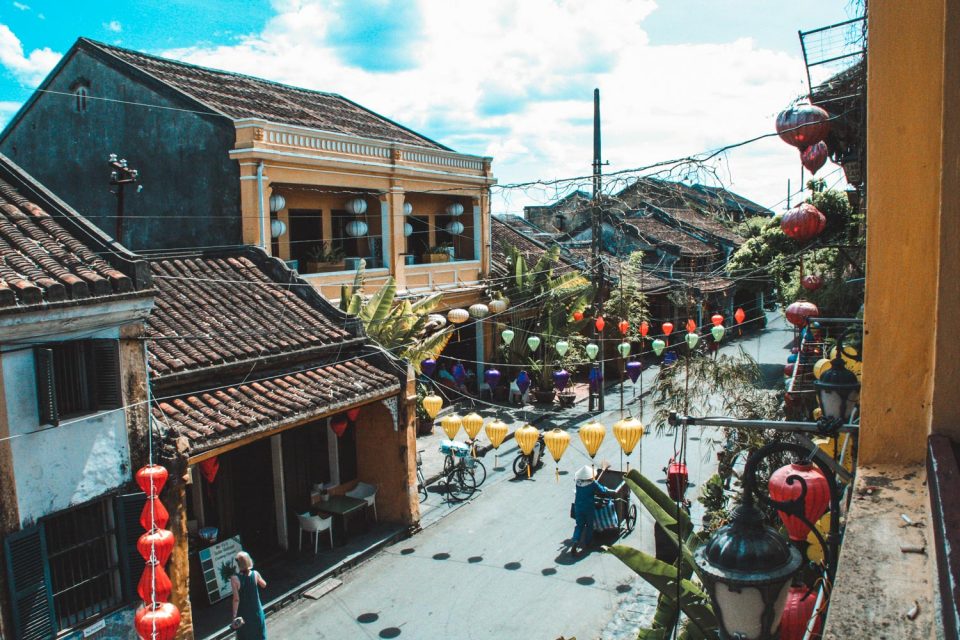
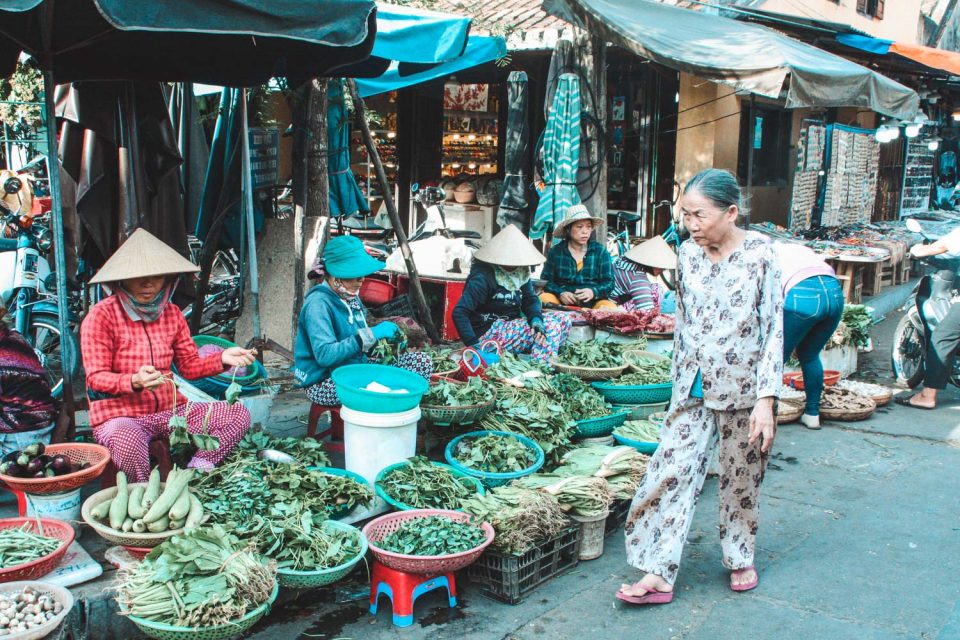
Hoi An Altstadt Tagsüber
Tagsüber ist die Altstadt für Autos und Roller gesperrt, was das Herumschlendern umso gemütlicher macht. Die Zeit zum idyllische Fotos machen, ist dann dank der vielen Mitreisenden vorbei, dafür haben die Geschäfte ihre Pforten geöffnet und jeder, der ein Faible für Handcraft-Läden hat, ist im siebten Himmel. Also ruhig die Gelegenheit nutzen und drauf los shoppen, denn hier findet man einzigartige Sachen, oft mit sozialem Hintergrund.
Vergesst nicht die 5 Sehenswürdigkeiten abzuklappern. Wir haben uns für eines der antiken Häuser entschieden, an dem wir eher zufällig vorbei kamen und das einem Händler gehört hat. Außerdem haben wir zwei Tempel besichtigt, eine Community Hall und eine Seidenweberei. Letztere war mit am interessantesten, denn offen gestanden wusste ich bis zu dem Zeitpunkt nicht, wie Seide produziert wird. Und dass die Seidenspinnerraupen dabei sterben. 🙁
Die berühmte japanische Brücke haben wir nur von außen begutachtet, denn möchte man sie überqueren, muss man eines seiner Tickets opfern und das ist die kleine Brücke eigentlich nicht wert.
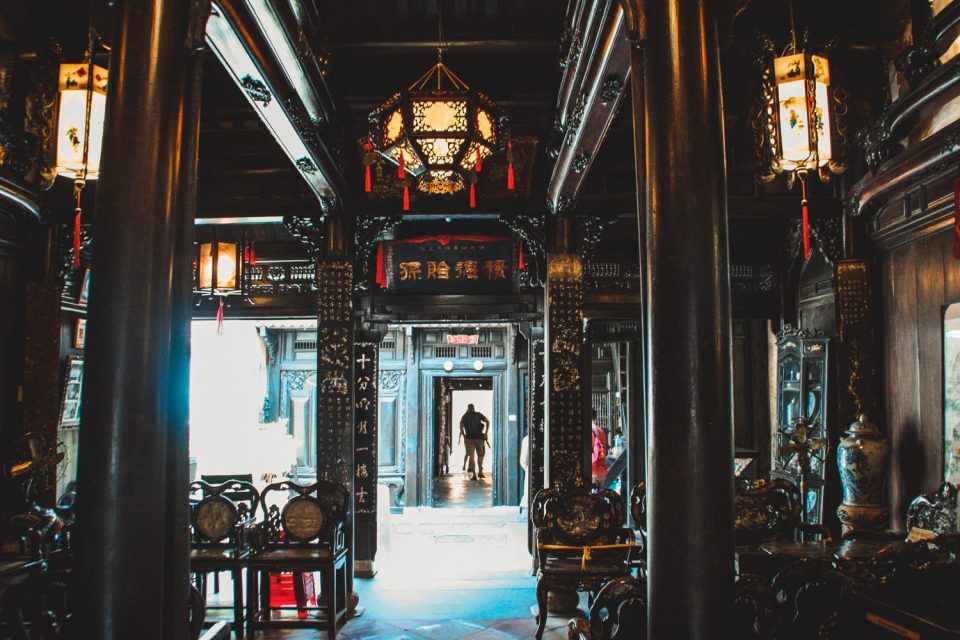
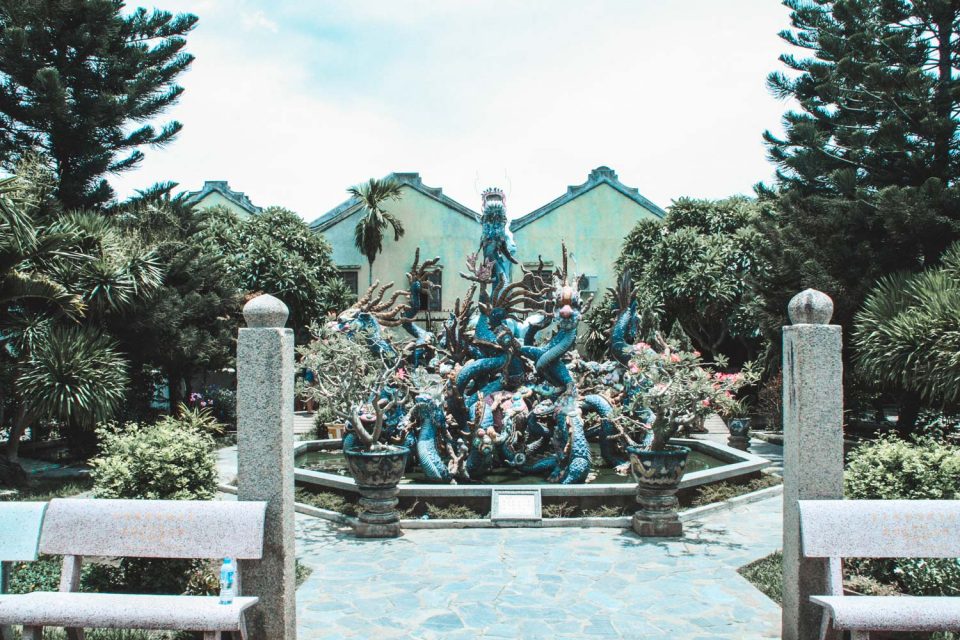
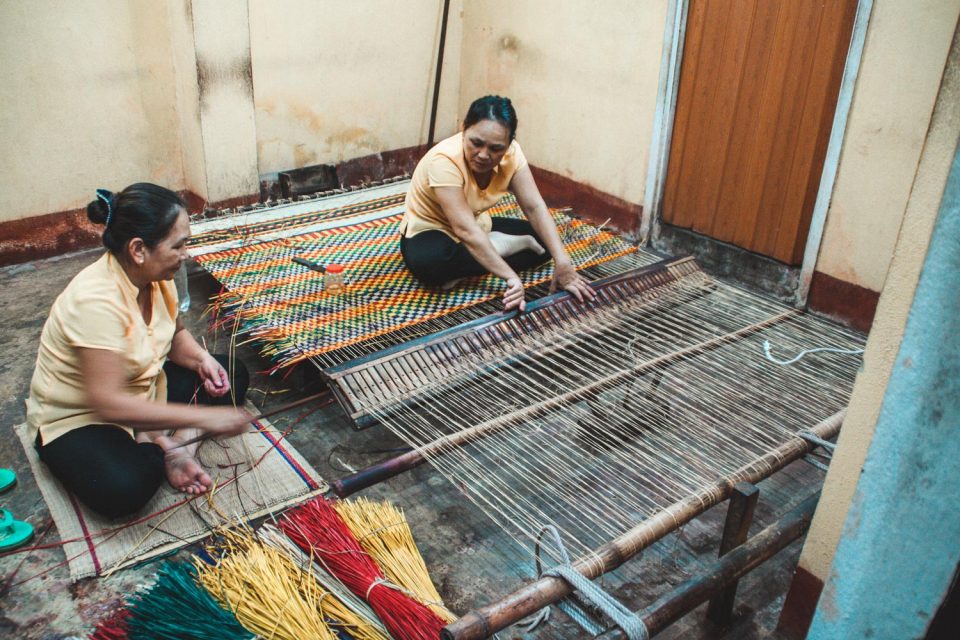
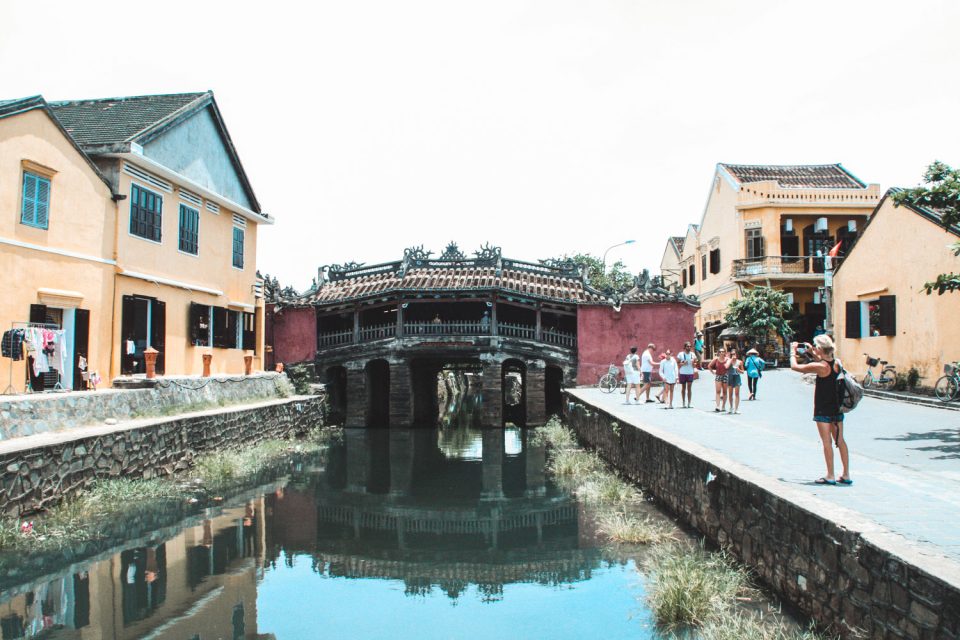
Hoi An Altstadt bei Nacht
Auch in der Nacht hat die Altstadt von Hoi An einiges zu bieten. Jetzt, wo die Temperaturen angenehmer werden und hunderte Lampions die Straßen in ein malerisches Licht tauchen, kommen die letzten Touristen aus den Löchern gekrochen. Es kann also wirklich unangenehm voll werden und an den Knotenpunkten kommt man nur mit Trippelschritten voran. Nichtsdestotrotz ein Erlebnis wert, denn hier sprudelt das Leben.
Hoi An Strände
Zum Glück für alle Sonnenanbeter hat Hoi An etwas außerhalb auch zwei Strände zu bieten. Der nähere ist der An Bang Beach, der dann irgendwann in den Cua Dai Beach übergeht. Beim ersteren, da leichter zu erreichen, sind mehr Touristen und damit auch mehr Lokale, kostenpflichtige Liegestühle usw. Wer es ruhiger mag, sollte also einfach zum Cua Dai Beach weiterziehen. Auch hier findet man Restaurants aber wesentlich vereinzelter und auch der Rest des Strandes ist etwas leerer. Es gibt mit Sicherheit schönere Strände, aber zum Ausspannen, Buch lesen und dem Altstadtrummel zu entfliehen, reicht es allemal.
Zu erreichen sind die Strände einfach mit dem Fahrrad (so lange das Hotel funktionstüchtige Fahrräder zur Verfügung stellt. Unser erster Ausflug war mehr als Schweißtreibend bei den Schrotthobeln) oder per Tuk Tuk oder Taxi.
https://www.instagram.com/p/BIv7ETXhW0g/
Maßschneiderei in Hoi An
Mein nicht gerade einfallsreicher Hoi An – Tipp ist sich etwas maßschneidern zu lassen. Die Stadt hat wirklich an jeder Ecke einen Schneiderladen und es lohnt sich sich ein bisschen zu erkundigen und einen Vergleich anzustellen. Das Preis-Leistungs-Verhältnis klafft hier teilweise stark auseinander. Wir haben uns einige Läden angesehen und sind schließlich bei Bi Bo gelandet (42 Tran Hung Dao). Die Damen waren sehr freundlich und erweckten im Gegensatz zur glänzenderen Konkurrenz nicht den Eindruck einer Touristen-Massenabfertigung. So kam es auch, dass wir am Ende mehr kauften, als geplant. Kostenpunkt für den Herrenanzug mit 1 Hemd und ein Extra-Sakko: ca. 150 Euro.
Auch Schuhe kann man sich in Hoi An schneidern lassen und das zu einem unschlagbaren Preis. Ich habe meine Schuhe sehr viel getragen und trage sie bis heute noch. Ich habe den Bewertungen auf Tripadvisor vertraut und wurde im Friendly Shoe Shop (18 Tran Phu) nicht enttäuscht. Kostenpunkt für Komplett-Leder-Sneaker: 55 Euro.
Übrigens mein Tipp an alle, die sich unbedingt was anfertigen lassen wollen: Macht nicht den Fehler und lasst euch irgendein Kleidchen schneidern oder sonst ein x-beliebiges Stück. Mit ziemlich hoher Wahrscheinlichkeit werdet ihr es nicht mehr tragen. Man ist so gefangen im Flair der Reise, dass man schnell etwas schneidern lässt, was eigentlich nicht in den Alltag passt. Das wurde mir jetzt schon von vielen Seiten berichtet. Deswegen mein Ratschlag: Überlegt euch ganz genau, was ihr schon immer haben wolltet oder gebrauchen könnt, was lange hält. Für Timo war es der Anzug mit passendem Hemd, da das noch in seinem Kleiderschrank fehlte. Für mich waren es die Sneaker, die ich so nie gefunden hatte, wie ich sie mir vorgestellt habe. So wurden beide Sachen nicht nur ein Urlaubs-Gag, sondern eine langfristige und sinnvolle Investition.
Ausflüge um Hoi An
Auch die Umgebung von Hoi An hat viel zu bieten. Sei es das Tra Que Herb Village oder eine Fahrrad-Tour durch die Reisfelder. Oder, unsere Wahl, ein Ausflug nach My Son, einer uralten Tempelstadt. Dieser Besuch beeindruckte uns zu tiefst. Nicht nur, dass die Anlage bereits seit fast 2000 Jahren existiert, auch die Schäden des Vietnamkrieges sind hier eindrucksvoll und erschreckend deutlich zu sehen. Die Anlage wurde während des Krieges stark bombardiert, denn hier hatten sich Truppen versteckt. So wurden 50 der insgesamt 70 Tempel zerstört. Man sieht bis heute die Krater und aufgeschütteten Erdberge, die die Bomben verursacht haben und man darf nicht abseits der Wege laufen, denn überall liegen noch Blindgänger. Das Gelände wird Stück für Stück in Millimeterarbeit danach abgesucht, was wir auch beobachten konnten. Es wird zwar versucht die Tempel wieder aufzubauen, aber die fugenlose Bauweise der Cham-Kultur ist bis heute nicht nachzubauen.
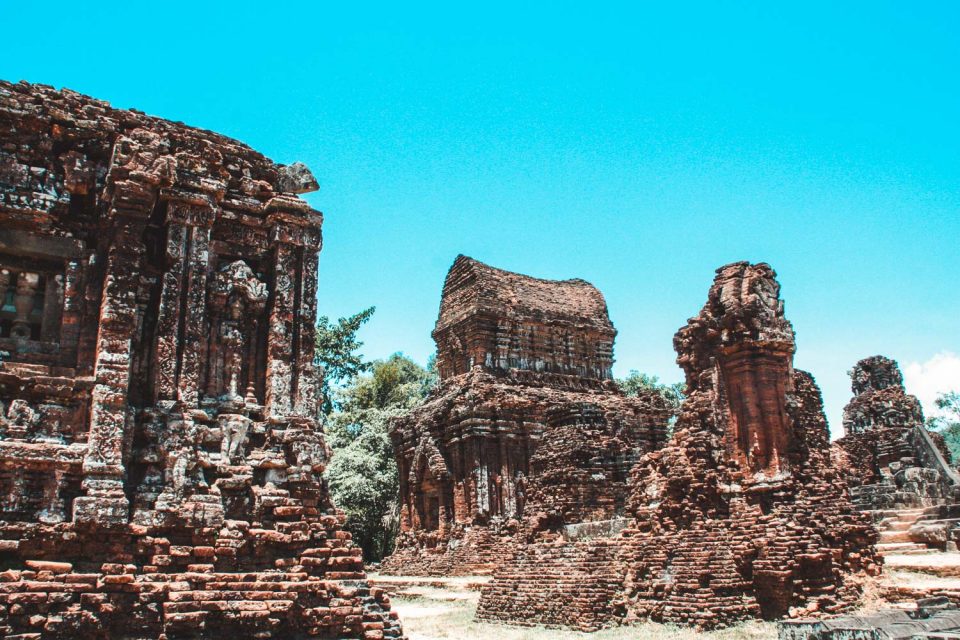
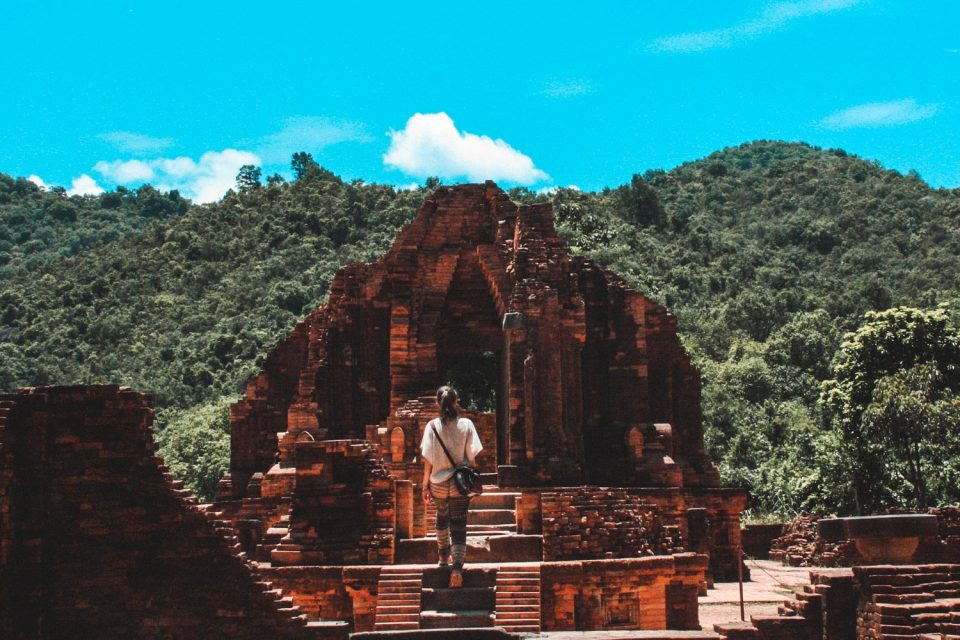
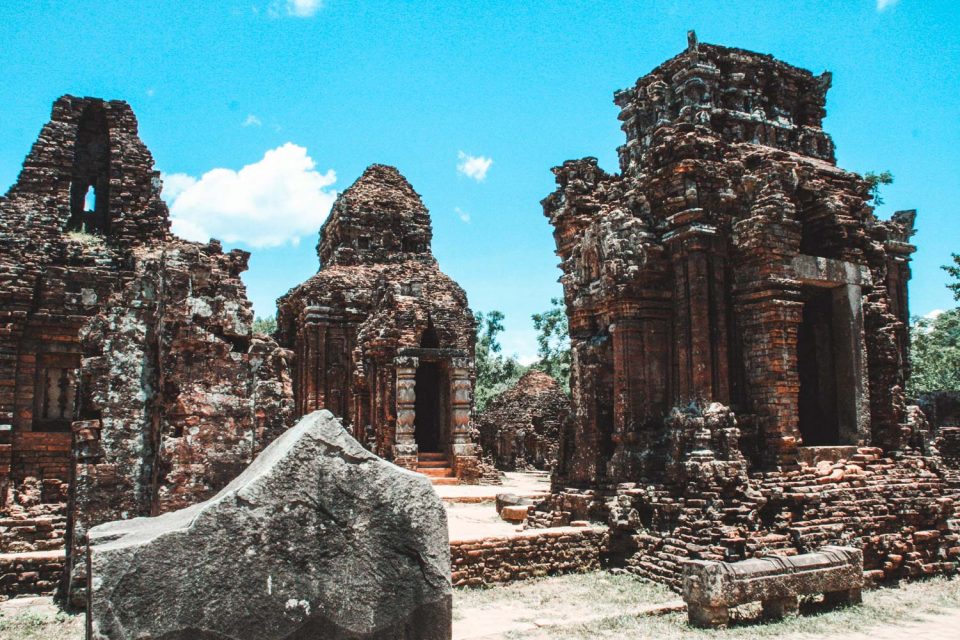
Ein eindrucksvoller Ausflug, der mit einer Bootsfahrt und einem Abstecher im Boots-Bau-Dorf endete. Auch wenn viele unserer Mitreisenden über das Essen an Bord mäkelten: Uns hat’s mehr als geschmeckt und meiner Meinung nach ein rund um zu empfehlender Ausflug.
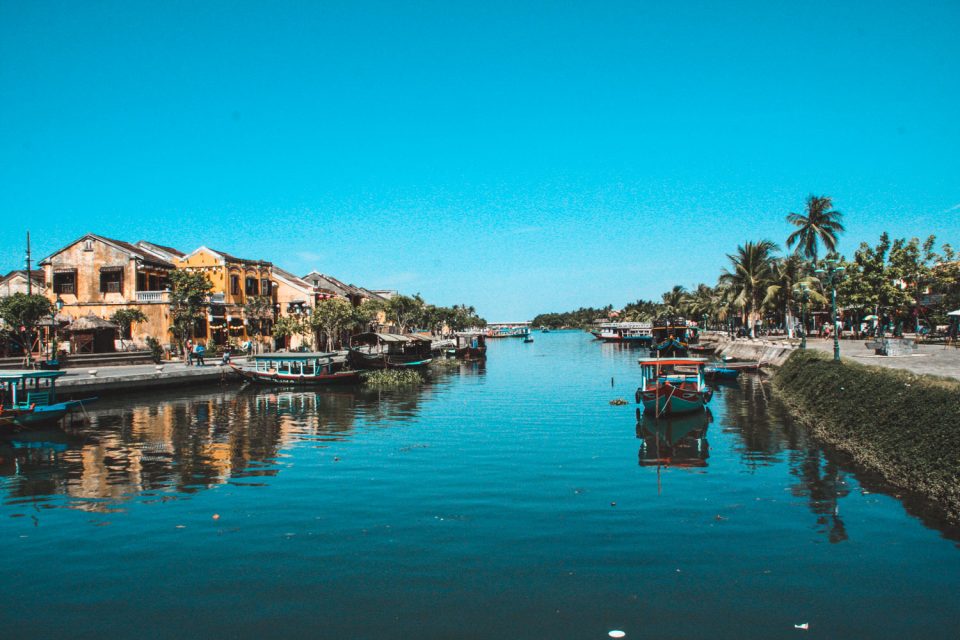
Weitere Hoi An – Tipps
Wenn ihr noch mehr über die Stadt wissen wollt, dann schaut doch bei Phototravelnomads, Love and Compass oder The Wanderblogger vorbei, die alle noch super Tipps für Unterkünfte, Restaurants und Ausflüge haben.
Habt ihr noch Tipps? Dann schreibt es mir in die Kommentare. Ich füge sie gerne ein.
English Version
_______________
Travel Report Hoi An – Tips for the most beautiful city in Vietnam
After exploring the north of Vietnam from Lan Ha to Sa Pa, we headed south. And here we have discovered the most beautiful city in the country. Maybe even the most beautiful city in Southeast Asia. Because Hoi An exudes a unique charm and caught us immediately. So much, that instead of the planned 2 nights we spent a whole week there.
I can only recommend any Vietnam traveler to include enough time for this city. Here are my Hoi An – tips for you 🙂
Tips in a Nutshell:
- Food, food, food
- Visit the old town in the morning
- Take advantage of the tourist ticket and immerse yourself in history
- Shopping!
- Falling into the evening bustle
- Relax on the beach
- Have something tailor made
- Visit My Son
The old town of Hoi An
In addition to the art of tailoring (which we will come to later) Hoi An is known for its beautiful old town, which is now also a UNESCO World Heritage Site. Well deserved, because this is a multicultural story. Hoi An was a popular port city for trade with Japan and China for many centuries. Later, Portuguese, French and Dutch trading companies settled down, which shaped the diversity of the city. Due to the silting up of the port, the dealers dodged Da Nang bit by bit, leaving the historic old town intact. Until today. History lesson finish. (Source: Wikipedia)
Of course you should go on a discovery tour in the narrow streets of the city. And at any time of day or night, because the old town has a lot to offer around the clock. Especially for food. That’s first mentioned, because in Hoi An you can feast extensively. Take the chance and try everything out 😉
The ominous ticket
Supposedly you have to buy a ticket to enter the old town. Whether that’s really mandatory or not, nobody seems to know. We were checked only once at the entrance in 7 days and then bought a ticket on this occasion. This is also valid as a ticket to 5 attractions of your choice and so we took the opportunity to dive a bit deeper into the history. All the days before we passed the entrances without a ticket and it was no problem. If you want to be on the safe side, just buy one, look at sights and carry it with you. The ticket is valid for 10 days and costs 4.50 €.
Hoi An old town in the morning
Who wants to experience the old town reasonably empty, should use the morning hours, when most tourists still sleep, have breakfast or are on day trips. Because the beauty of the city has unfortunately gotten around and especially in the summer months it can be quite crowded. But in the morning, most shops are not open and so you can experience the city a bit emptier.
You can also make a detour to the market, where traders sell their fresh vegetables, herbs, fruits and all sorts of things. The market is quite large and actually there throughout the day.
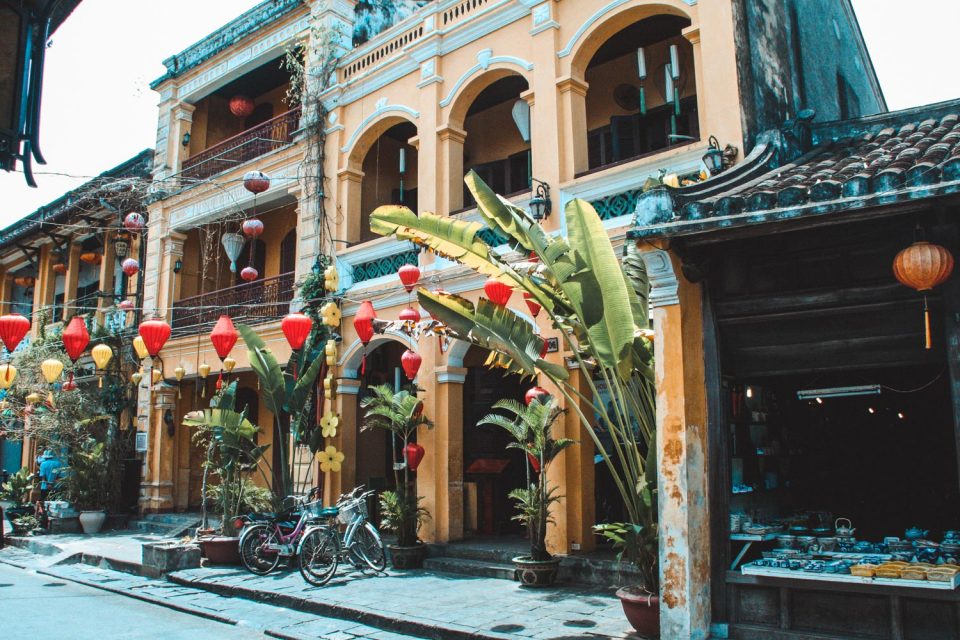
Hoi An Old Town Daytime
During the day the old town is closed to cars and scooters, which makes it all the more comfortable to stroll around. The time to take idyllic photos is then over thanks to the many fellow travelers, but the shops have opened their doors and anyone who has a penchant for handcraft shops, is in seventh heaven. So take the opportunity to go shopping, because here you can find unique things.
Do not forget to check out the 5 sights. We opted for one of the old houses that we happened to pass by and that belonged to a salesman. We also visited two temples, a community hall and a silk weaving mill. The weaving mill was the most interesting, because frankly I did not know how silk was produced until then. And that the silk moths are dying.
We only looked at the famous Japanese bridge from the outside, because if you want to cross it, you have to sacrifice one of your tickets and that’s not worth the little bridge.
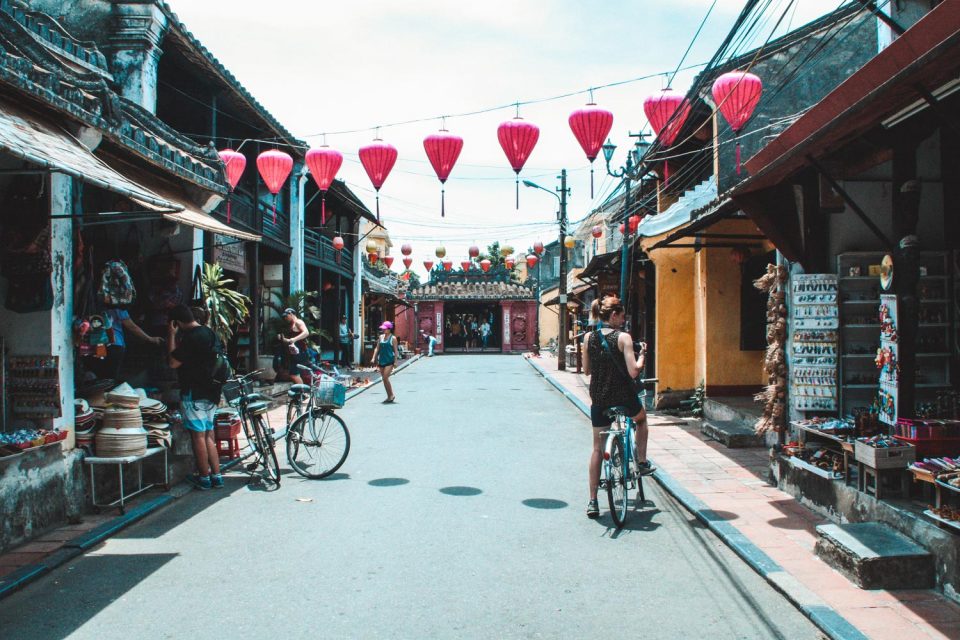
Hoi An old town at night
The old town of Hoi An also has a lot to offer at night. Now that the temperatures are getting more pleasant and hundreds of lanterns dive the streets into a picturesque light, the last tourists are crawling out of the holes. So it can be really uncomfortably crowded and at the junctions you get ahead only with triple steps. Nevertheless, worth a visit, because life is bubbling here.
Hoi An beaches
Luckily for all sunbathers, Hoi An also has two beaches just near by. The nearest one is the An Bang Beach, which then eventually merges into the Cua Dai Beach. At the former one, because easier to reach, are more tourists and therefore more restaurants, chargeable beach chairs, etc. If you like it quiet, you should just move on to Cua Dai Beach. Here you will find restaurants but much more isolated and the rest of the beach is emptier. There are certainly nicer beaches, but to relax, to read book and to escape the turmoil, it is enough.
The beaches are easy to reach by bike (as long as the hotel provides working bicycles, our first outing was more than arduous) or by tuk tuk or taxi.
Tailoring in Hoi An
My unimaginative Hoi An – tip is to get something tailor made. The city really has a tailor shop on every corner and it’s well worth a while to inquire and make a comparison. The price-performance ratio gap here sometimes strong. We looked at a few shops and ended up at Bi Bo (42 Tran Hung Dao). The ladies were very friendly and, in contrast to the brighter competition, did not give the impression of a tourist mass processing. So it was that we ended up buying more than we had planned. Cost of the men’s suit with 1 shirt and an extra jacket: about 150 euros.
You can also tailor shoes in Hoi An for an unbeatable price. I have worn my shoes very much and still do today. I trusted the reviews on Tripadvisor and was not disappointed in the Friendly Shoe Shop (18 Tran Phu). Cost of complete leather sneaker: 55 euros.
By the way, my tip to all those who really want to have something made: Do not make the mistake and let you tailor any little dress or a x-any piece. With a high degree of probability you will not wear it anymore. One is so trapped in the flair of the journey, that one can quickly tailor something that does not really fit into everyday life. This has already been reported to me from many sides. So my advice: Think carefully about what you always wanted or could need, which lasts long. For Timo, it was the suit with matching shirt that was missing in his wardrobe. For me it was the sneakers that I had never found, as I imagined. So both things were not just a holiday gag but a long-term and meaningful investment.
Excursions around Hoi An
The surroundings of Hoi An also have much to offer. Be it the Tra Que Herb Village or a bicycle tour through the rice fields. Or, our choice, a trip to My Son, an ancient temple city. This visit impressed us deeply. Not only that the plant already exists for nearly 2000 years, also the damages of the Viet Nam war are to be seen here impressively and frighteningly clearly. The plant was heavily bombed during the war, because troops had hidden here. Thus, 50 of the total of 70 temples were destroyed. You can still see the craters and the heaped-up mountains of earth that caused the bombs and you can not run off the roads, because there are still dud bombs everywhere. The terrain is searched piece by piece in millimeter work, which we were able to observe. Although it is trying to rebuild the temples, but the seamless construction of the Cham culture is not replicate today.
An impressive excursion that ended with a boat trip and a detour in the Boat Construction Village. Even though many of our fellow travelers complained about the food on board: We liked it a lot and in my opinion an all-round excursion.
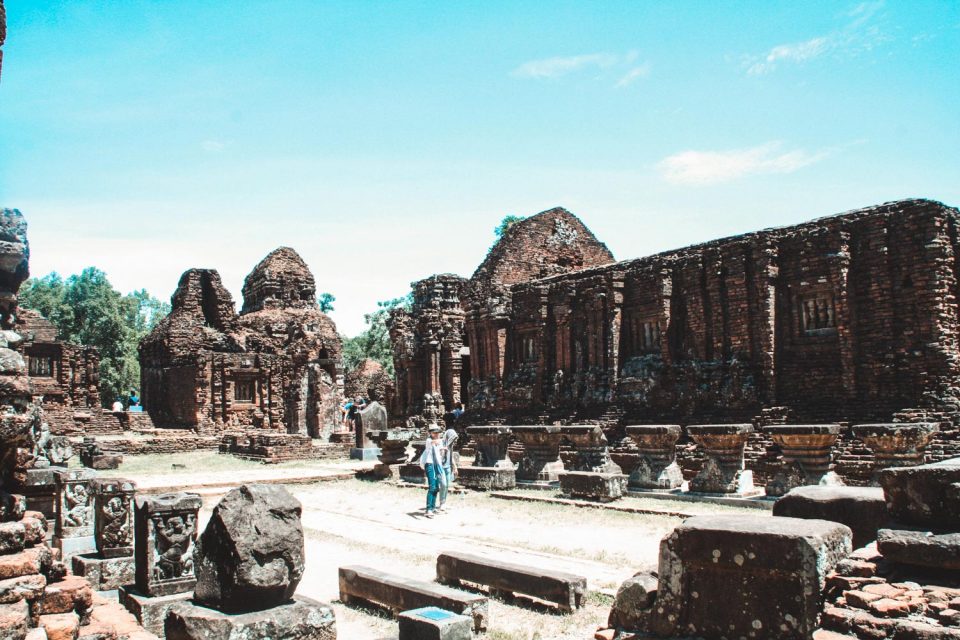
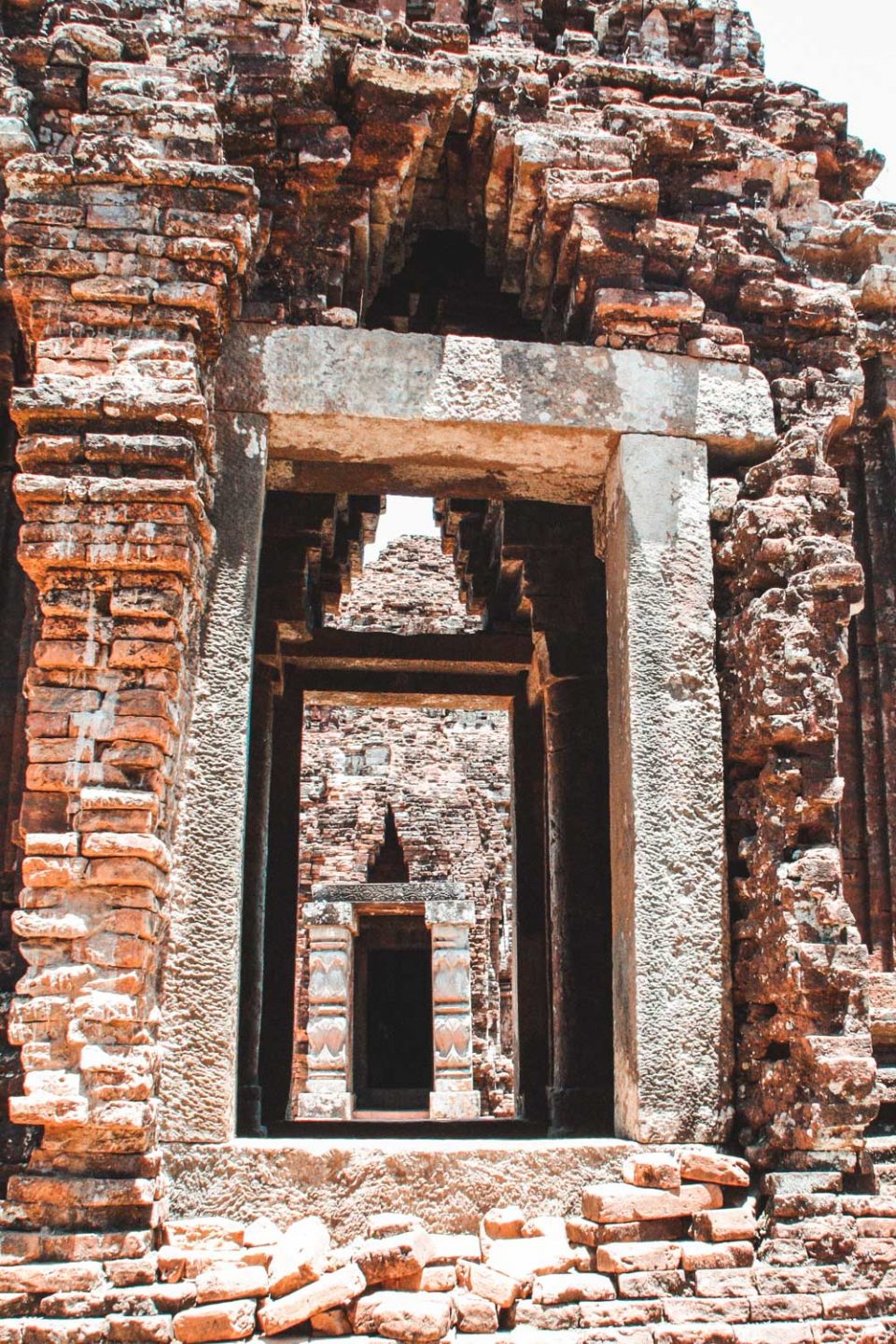
More Hoi An – Tips
If you want to know more about the city, check out Phototravelnomads, Love and Compass or The Wanderblogger, all of which are great tips for accommodation, restaurants and outings.







12 Comments
Marvena
7 Jahren agoIch war noch nie in Vietnam, doch dein Artikel und die Bilder haben mit richtig neugierig auf das Land und die Kultur gemacht! Gerade für diese tollen Märkte und die alten Stadtteile schlägt mein Reiseherz! 🙂
Liebe Grüße
Marvena
https://the-fashion-circus.com
Dorie
7 Jahren agoAlso ich kann Vietnam nur jedem empfehlen, es ist wirklich ein schönes Land. Noch nicht ganz so überlaufen wie Thailand (von Hoi An jetzt mal abgesehen, haha) und trotzdem bequem zu bereisen 🙂
Liebe Grüße!
Annika
7 Jahren agoEin toller Reisebericht 🙂
Dorie
7 Jahren agoVielen lieben Dank 🙂
miras_world_com
7 Jahren agoIch habe schon vor Jahren an eine Vietnam Reise gedacht, es kam aber nicht dazu. Deine Beschreibung klingt interessant. Ich bin auch eher der Entdecker Typ. nur im Hotel und gleichen Strand sitzen ist für mich nicht zufriedenstellend. Tolle Bilder! Liebe Grüße!
Dorie
7 Jahren agoAlso ich kann Vietnam wirklich nur empfehlen, es ist ein wunderschönes Land – vor allem für Entdecker 🙂
Liebe Grüße!
Reni E.
7 Jahren agoDas ist wirklich ein toller Reisebericht. Da hast du etwas Wunderschönes erlebt. Da hat man lange etwas von.
Liebe Grüße
Reni
Dorie
7 Jahren agoJa, das war wirklich ein Aufenthalt, den ich nicht vergessen werde 🙂
Liebe Grüße!
Tom
7 Jahren agoTolle Fotos, auch dass Du die Menschen dort so direkt fotografieren konntest. Spitze, ich hab mal in Mexiko auf nem Markt versucht 2 Marktfrauen zu fotografieren und gleich Ärger bekommen. Also weiterso mit Deinen Berichten!
Dorie
7 Jahren agoDankeschön 🙂 Es kommt immer auf die Situation drauf an. Meistens bitte ich schon um Erlaubnis und deute den Menschen an, dass ich die fotografieren will. Dann hat auch noch nie jemand nein gesagt. Hier und da verlangt es natürlich die Situation, dass man einfach den Moment einfängt. Dann ist es von Vorteil, wenn der Mensch nicht gerade in dem Moment her schaut, haha. 😀 In Asien sind die Menschen aber allgemein nicht sonderlich Kamerascheu 🙂
Sandra
7 Jahren agoDas sieht wirklich toll aus!
Dorie
7 Jahren agoEs ist auch eine wunderschöne Stadt 🙂